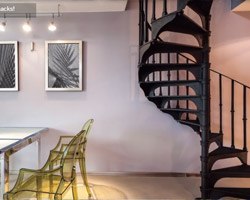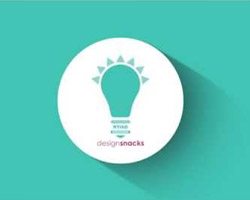#15 – There’s More to Life than Work
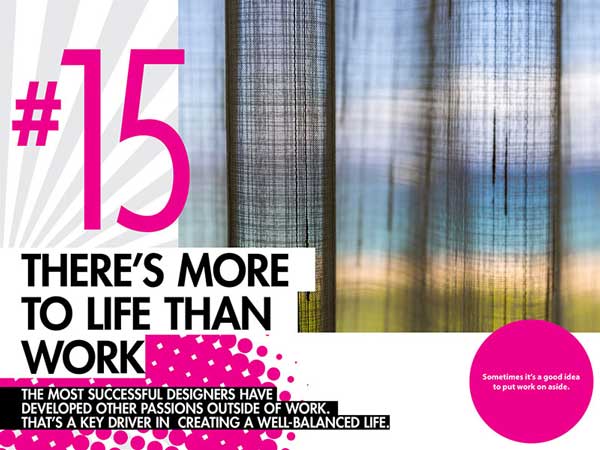
The most successful designers have developed other passions outside of work. That’s a key driver in creating a well-balanced life.
Sometimes it’s a good idea to put work on aside.
As I’ve looked at the people I know who have been successful in the creative professions, it’s easy to say that they all have a strong passion for their work. But the most successful designers and decorators I know have developed passions outside of work as well. And I think that’s a key driver in creating a well-balanced life.
Some designers I know love collecting wine. A lot of decorators I know are passionate about music. One very successful decorator that I know has got a band and he plays music. I’ve heard his music. I’ve seen his designs. I know the two feed each other in an inextricable way.
I know another designer who has a passion for cooking. Another friend loves movies. He travels nine or ten months out of the year. When he gets home he likes to put everything away for a bit and watch a stack of movies—three or four in a day. All that visual information feeds his passion for decoration.
This last observation may seem contrary to many of the things I said so far, but sometimes it’s a good idea to put your work up on a shelf. Find other things in life to carry you forward—family, friends, and hobbies. They will help complete the design of your life in the biggest sense.
#14 – Nobody Does it Alone
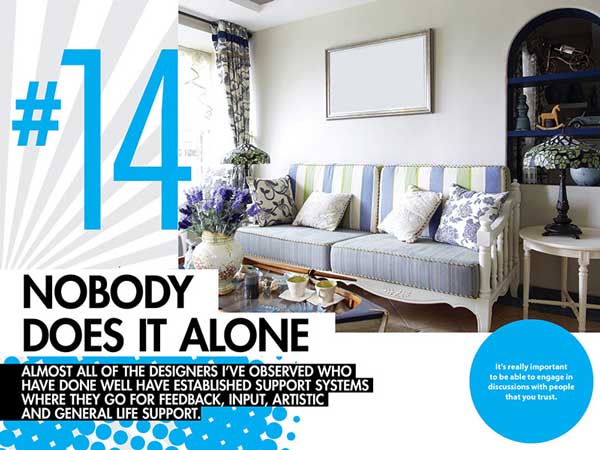
Almost all of the designers I’ve observed who have done well have established support systems. It’s really important to be able to engage in discussions with people that you trust.
Creatives can tend to take on a lot. They take on projects, often multiple projects at one time, and work with very little interfering with their process. As we look at successful designers and decorators one of the things that pop out is the importance of partnerships in their lives. Almost all of the creatives I’ve observed who have done well have established support systems where they go for feedback, input, artistic and general life support.
It may be a relationship with your spouse, or it might be with other designers. The point is to get this organic feedback and bounce ideas off of other people. A great way to develop these relationships is to join professional associations where you meet other designers and decorators and see what they are doing. They are your tribe. And you can benefit tremendously from their company, where they go for feedback, input, artistic and general life support.
#13 – Innovate

The quest for innovation will likely be nonstop for successful designers throughout their lives. The best of us will always be wondering how to do it differently.
Do we try new materials? Do we use different colors or introduce new elements into a scene?
The truth is probably a combination of all of the above. The tools we have available to us today are endless. Oddly enough, given all the tools available to us, the overwhelming abundance before us, it’s actually easier now than it’s ever been to create an original design.
Once you’ve found your tool kit and defined your process at every step of room creation, you will start to develop your visual signature. And if you’re known as someone who can make a room that’s comfortable as well as aesthetically pleasing, you’ve got your football inside the five-yard line. Even getting to that point might be enough to separate you from everyone else.
But we can’t assume that once we develop a visual signature, it will stay static. If it did, we’d end up creating the same rooms for our entire career. We evolve as people and we will evolve as artists. Spaces that once looked great to you may not look as good as you move forward. You should always be creating a stronger visual signature.
#12 – Know Your Extended Family
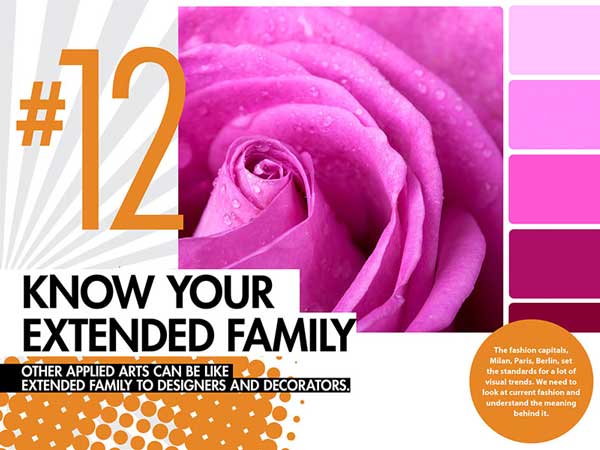
Other applied arts can be like extended family to designers and decorators.
The fashion capitals, Milan, Paris, Berlin, set the standards for a lot of visual trends. We need to look at current fashion and understand the meaning behind it.
And we need to look at current fashion to be informed about what’s coming.
Fashion impacts how we see things, how color is determined, and even what colors we use in spaces. Do an Internet search and go to Pantone, the color people. Or just Google color trends or color forecast, and you’ll see that forecast for colors of cars or furniture, or clothing, or paint colors for homes, they’re all established about two years ahead of time. All we have to do is become aware and take that in. And while we don’t chase trends when creating spaces, we need to be informed so that we can really hear our client’s references.
#11 – Speak a Global Visual Language
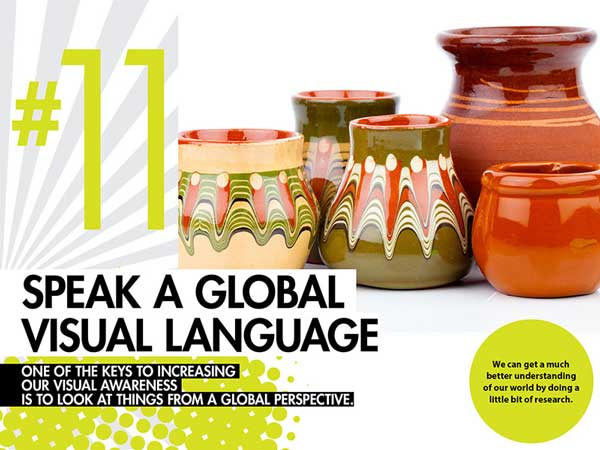
One of the keys to increasing our visual awareness is to look at things from a global perspective.
We can get a much better understanding of our world by doing a little bit of research.
We live in a large world that’s becoming smaller because of digital technology. Its easy now for us to see what things look like in Singapore, or Shanghai, or Rio or Dubai. We can get a much better understanding of our world by doing a little bit of research.
As Americans, we tend to be fairly geocentric in our approach. We see what we see in our daily lives. But one can expand their vision without even getting on an airplane today. And when we make the effort to widen our vision, we get a much more rounded impression of the world and that can have a positive effect on our designs. The most successful designer’s know to learn from our friends around the world. It helps us find our place despite our location.
#10 – Listen
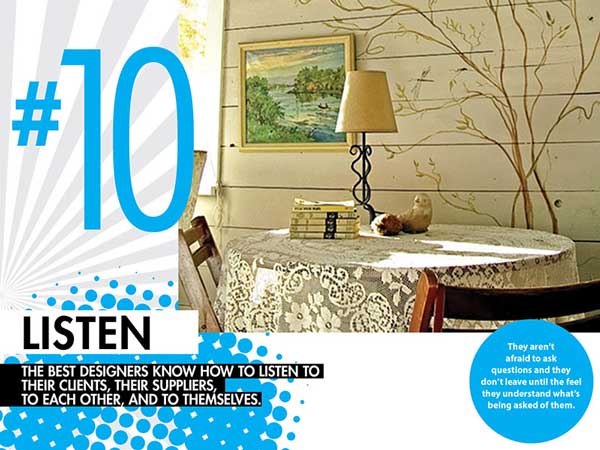
The best designers know how to listen to their clients, their suppliers, to each other and to themselves.
They aren’t afraid to ask questions and they don’t leave until the feel they understand what’s being asked of them.
A well-known designer once said to me, “there’s a reason we’re born with two ears and only one mouth.” The best designers and decorators know how to listen to their clients, their suppliers, craftsman, to each other, and to themselves. They aren’t afraid to ask questions and they don’t leave a topic or a meeting until the feel they understand what’s being asked of them.
#9 – Value the Information Quest
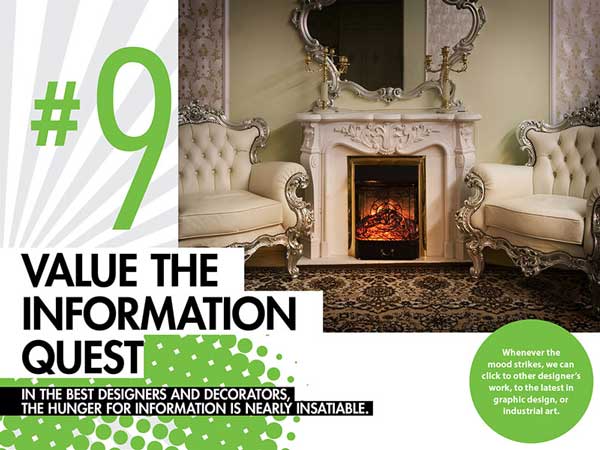
In the best designers and decorators, the hunger for information is nearly insatiable.
The Internet provides us with an unobstructed view of the world around us. Whenever the mood strikes, we can click to other designer’s work, to the latest in graphic design, or industrial art. What this contributes to is the development of our visually literacy. In the best designers and decorators, this hunger is nearly insatiable.
In the old world designers walked through museums, stately homes, and poured over print media. We all looked at stacks of random magazines. We poured over layouts and tried to decipher the styles, colors and textures we saw. Now, of course, it’s so much easier to stay attuned to innovations and changes in materials and thinking. And don’t only look at the images and the advertisements, but read the papers and find out what’s happening in the world.
More and more, your clients will be people from diverse and rich cultures, from all over the globe. The best designers and decorators today have a world view that’s far wider than their spot on the map. Be broad. Be worldly. Be rich in information and inspiration.
#8 – Right Brain, Left Brain
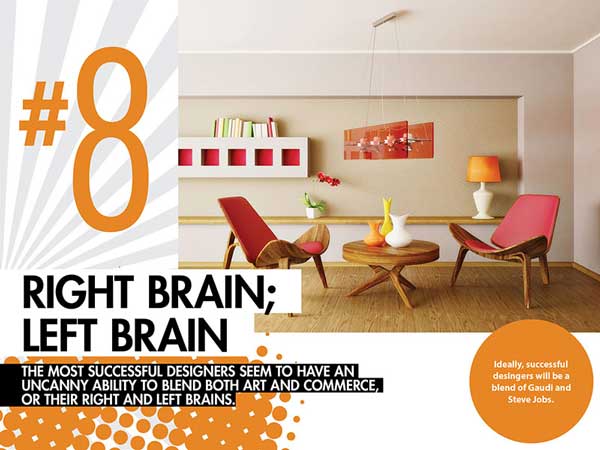
The most successful designers seem to have an uncanny ability to blend both art and commerce, or their right and left brains.
Ideally, successful designers will be a blend of Gaudi and Steve Jobs.
Think of Warren Buffet. If success is defined as making money, then he is certainly successful. As designers, many of us do have to think about running a business and getting things set up in the appropriate way. Now think of Steve Jobs He was actually a pretty good businessman, but his passion was the creation of really innovative, functional design. Ideally, successful designer will be a blend of both.
Most of us are better at one side of things than the other. No one is ideally split 50/50 art and commerce. But if you recognize your deficits, you can partner with someone who is strong where you’re weaker, and all the bases will be covered. It’s a matter of knowing yourself and places where you’re balanced and where you’re a little weak.
#7 – Be Optimistic
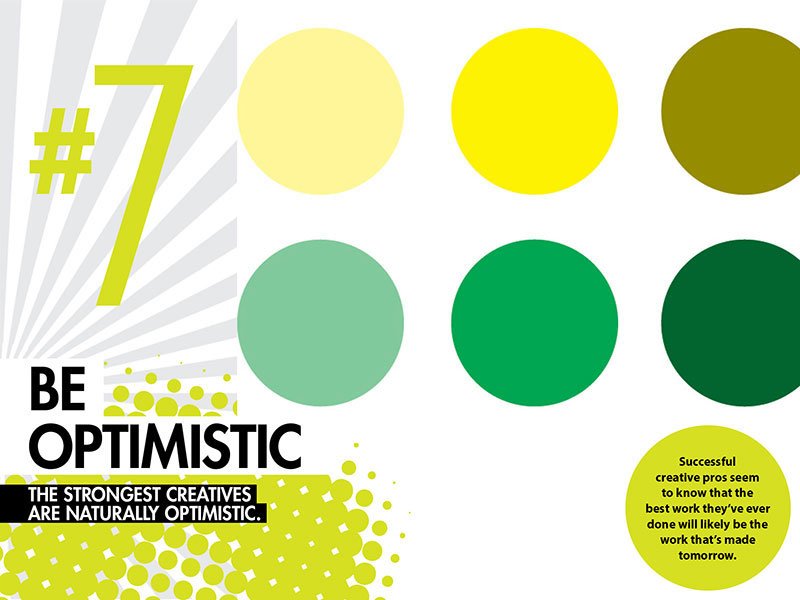
The strongest creatives are naturally optimistic.
Successful creative pros seem to know that the best work they’ve ever done will likely be the work that’s made tomorrow.
I don’t know whether you can be trained to be optimistic or if you have to be wired in that way. But connected to their ability to overcome adversity, is this inherent sense of optimism.
There’s an abiding sense of confidence that their best work is ahead of them. They stay pumped and motivated. They stay solid.
This is not to say that these interior designers are not wholly engaged in the world as it really is, but strong faith in the future keeps them excited about the possibilities that exist in the world of design.
#6 – Fail, Then Fail Again
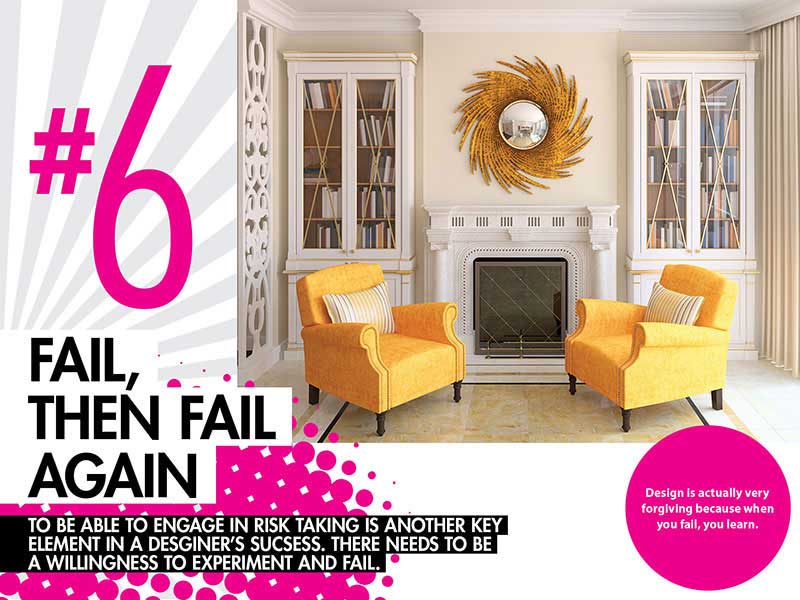
To be able to engage in risk taking is another key element in a designer’s success. There needs to be a willingness to experiment and fail.
Design is actually very forgiving because when you fail, you learn.
We should not hesitate to try everything at our disposal in the pursuit being unique. This necessarily means that there will be a fair amount of failure. If we talk to any notable designer or decorator, they will talk about the risks that they’ve taken and the failures they’ve had and what they’ve learned from it. Don’t be afraid to be wrong. Be afraid to be right too much of the time. Take whatever chances you can.
The notion of risk taking separates successful designers from less successful designers. When I teach, my students get big points for failure. I encourage them to go out and try something they would never dreamed possible. If they fail, they get a high mark.
#5 – Edit, Then Edit Again
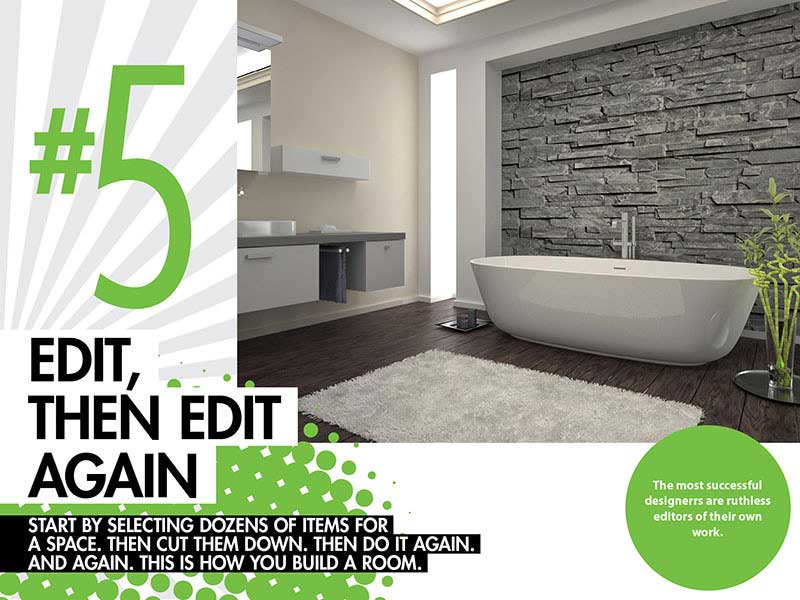
Start be selecting dozens of items for a space. Then cut them down. Then do it again, and again. This is how you build a room.
The most successful designers are ruthless editors of their own work.
Be a ruthless editor of your own work. But also know when a job is completed. Some designers and decorators feel that a room is never finished. At NYIAD, we don’t think so. A room may be finished, but can continue to evolve. It’s an organic thing, after all. There’s no saying that a completed room will not be refined or added to or subtly changed over time. And it should be. But every project, every room, tells a story. That story has a beginning, a middle and an end. The ending is there. You have to train yourself to see it.
#4 – Think of Yourself as a Surgeon
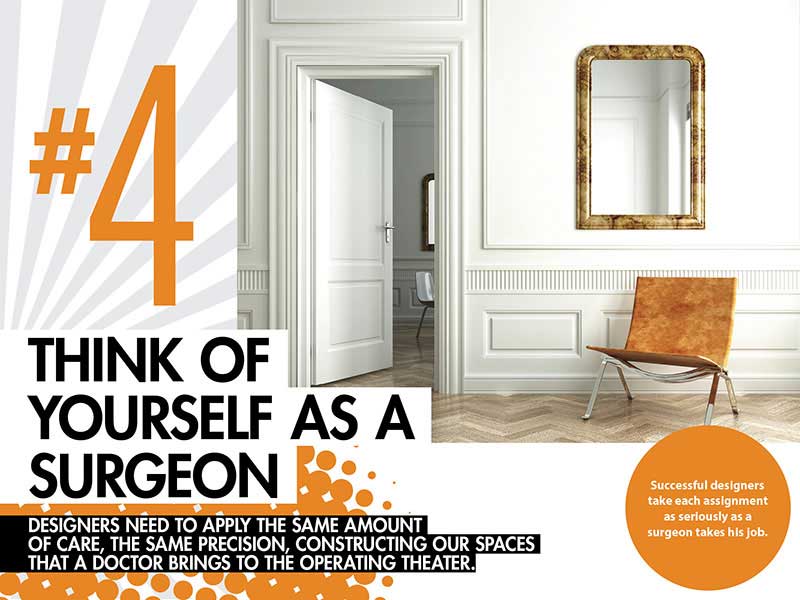
Designers need to apply the same amount of care, the same precision, constructing our spaces that a doctor brings to the operating theater.
Successful designers take each assignment as seriously as a surgeon takes his job.
If designers and decorators think of themselves as surgeons, they’re going to bring their best game to work everyday. Lives depend on it. A designer’s life is really no different in that we want to bring our best game into play at every juncture. The best decorators I’ve known tend to be perfectionists. They love the details. The big picture and the small.
#3 – Professional Development is a Necessity
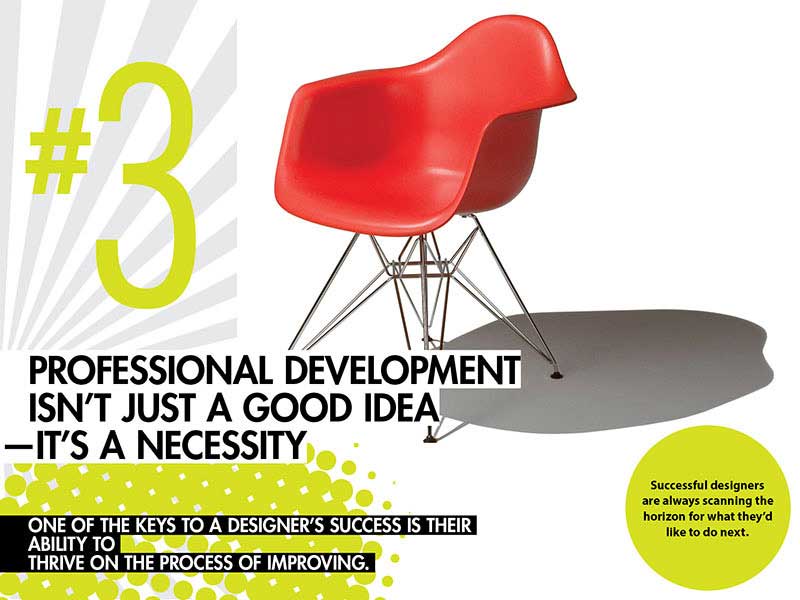
One of the keys to a designer’s success is their ability to thrive on the process of improving. Successful designers are always scanning the horizon for what they’d like to do next.
How do you see your work developing and what would you like to do next? Successful designers are always scanning the horizon for what they’d like to do next.
Not all kinds of design and decoration are equally enjoyable to all designers. Some love to do homes and they wouldn’t design anything else. Others like to work exclusively on workspaces. It all depends on how we’re wired. But one of the things that the most successful designers have always had in common is their focus. They make choices and they persist. The ability to make a choice sets them apart. Because once you make a choice, you’ve made a commitment.
#2 – Stand Out and Stand Tall
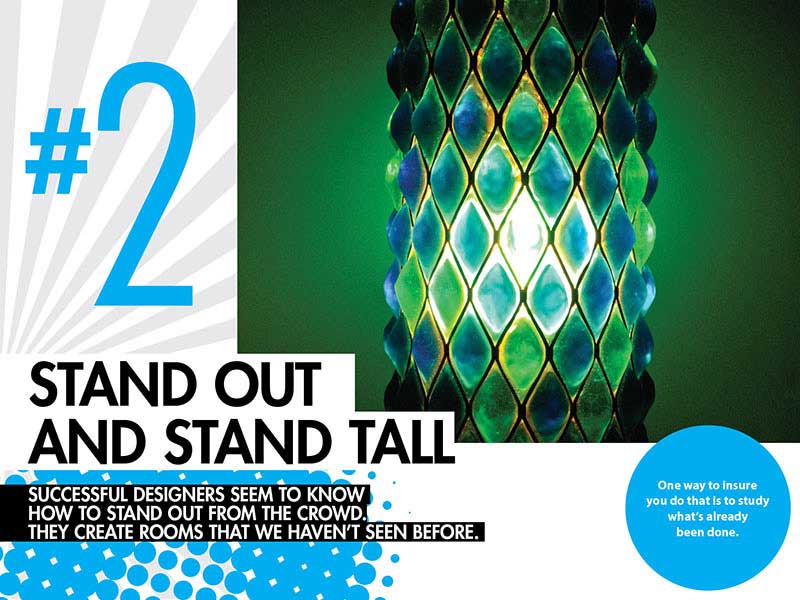
Successful designers seem to know how to stand out from the crowd. They create rooms that we haven’t seen before.
One way to insure you do that is to study what’s already been done.
To master any field you need a foundation of knowledge on which to build your expertise. Study the history of design and develop an understanding of the current state of interior design in order to build effectively upon it. You must know where the box is in order to think outside of it. Great designers have an unquenchable curiosity. Submerge yourself in the designs of the past, and with this understanding, produce a truly original style own your own.
#1 – Always Be Aware
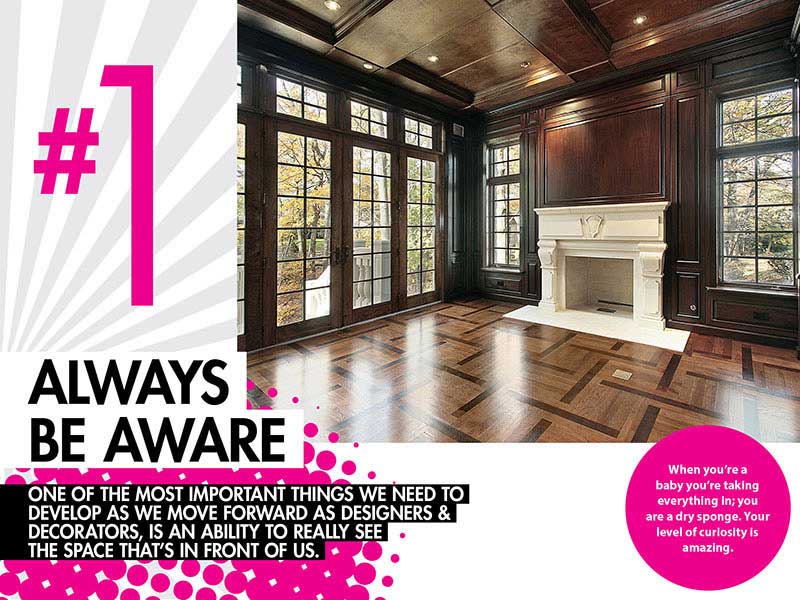
One of the most important things we need to develop as we move forward as designers and decorators is an ability to really see the space that's in front of us.
When you're a baby you're taking everything in; you are a dry sponge. Your level of curiosity is amazing.
As we grow our eyes tend to ignore things that may be familiar to us because we've seen them hundreds of times before. But really successful designers have the ability to see even familiar things in an acute way that can be stunning. They know how to train themselves to see things anew and to catch themselves if they are looking past things. Very successful designers retain their baby eyes. They nurture and prize awareness of space and elements.
Stay tuned next week for the next part in our series of 15 Habits of Successful Designers.
Want to learn more? The New York Institute of Art and Design is the #1 online interior design school in the world. Get started today!


